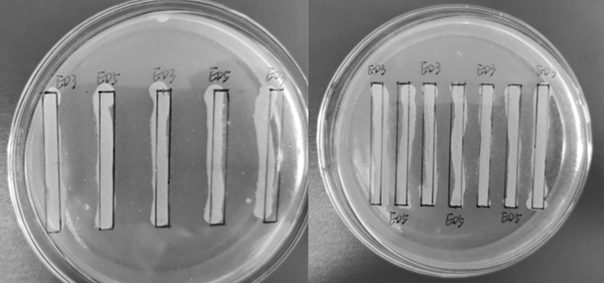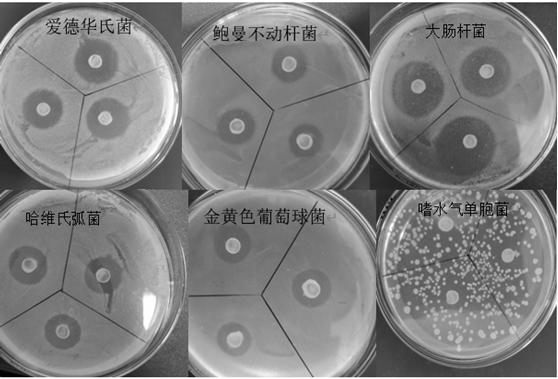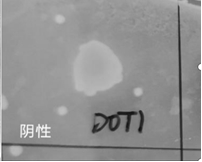Antagonist ed5 and its application
A technology of antagonistic bacteria and bacterial agents, applied in the field of microorganisms, can solve problems such as mutations, food safety issues, and drug resistance of pathogenic bacteria
- Summary
- Abstract
- Description
- Claims
- Application Information
AI Technical Summary
Problems solved by technology
Method used
Image
Examples
Embodiment 1
[0046] Example 1 Isolation and selection of intestinal bacteria and pathogenic bacteria
[0047] (1) Isolation of intestinal bacteria
[0048] Select fresh Japanese hairtail purchased from Weihai Yuanyao Market ( Trichiurus lepturus). Clean the fish with sterilized seawater, wipe the body surface of the fish with 75% alcohol, cut the abdomen of the fish with scissors, take the complete intestinal tract, and place it in PBS buffer solution for later use; squeeze out the contents of the intestinal tract before sterilization Centrifuge tubes, dilute the homogenate with sterile seawater at a ratio of 1:9.
[0049] Direct coating culture method: Take 10ml of the homogenate and place it in a 50ml Erlenmeyer flask filled with 40ml of sterilized seawater (the bottom of the bottle is covered with glass beads before sterilization), put it in a shaker at 20°C, 120rpm, and culture on a shaker 30min to obtain the bacterial suspension mother liquor. In the ultra-clean workbench, use st...
Embodiment 2
[0054] Example 2 Screening of antagonistic bacteria
[0055] The bacteria to be tested were planted on a plate coated with pathogenic bacteria, and placed in a 28°C incubator for 24 hours. Both the bacteria to be tested and the pathogenic bacteria grew well, and the inhibition zone was observed. The experimental results are shown in Table 1. 2.
[0056] Among the 6 pathogenic bacteria, only Staphylococcus aureus was Gram-positive bacteria, and the remaining 5 pathogenic bacteria were all Gram-negative bacteria. When the intestinal bacteria to be tested have an antagonistic effect on pathogenic bacteria, a transparent and well-defined inhibition zone will appear around the colonies of the bacteria to be tested, such as figure 1 ; When the intestinal bacteria to be tested do not have antagonism to pathogenic bacteria, no zone of inhibition will appear, and the antagonism is negative, such as figure 2 .
[0057] Table 1 Primary screening results of antagonistic bacteria
[...
Embodiment 3
[0063] Example 3 In Vitro Hemolysis Experiment
[0064] The screened antagonistic bacteria to be tested were inoculated on a blood agar plate and cultured upside down in a 28°C incubator. It can be seen from Table 3 that the antagonistic bacteria ED5 did not produce hemolytic circles.
[0065] Table 3 In vitro hemolysis test results
[0066]
[0067] When the bacteria have hemolytic ability and enter the fish body, they will cause a large number of red blood cells to rupture in the body, causing hemoglobin to leak out of the cells, thereby triggering a series of reactions such as anemia and destruction of the immune system. Table 3 shows that the antagonist ED5 does not produce hemolysis, indicating that the antagonist has certain safety.
PUM
 Login to View More
Login to View More Abstract
Description
Claims
Application Information
 Login to View More
Login to View More - R&D
- Intellectual Property
- Life Sciences
- Materials
- Tech Scout
- Unparalleled Data Quality
- Higher Quality Content
- 60% Fewer Hallucinations
Browse by: Latest US Patents, China's latest patents, Technical Efficacy Thesaurus, Application Domain, Technology Topic, Popular Technical Reports.
© 2025 PatSnap. All rights reserved.Legal|Privacy policy|Modern Slavery Act Transparency Statement|Sitemap|About US| Contact US: help@patsnap.com



